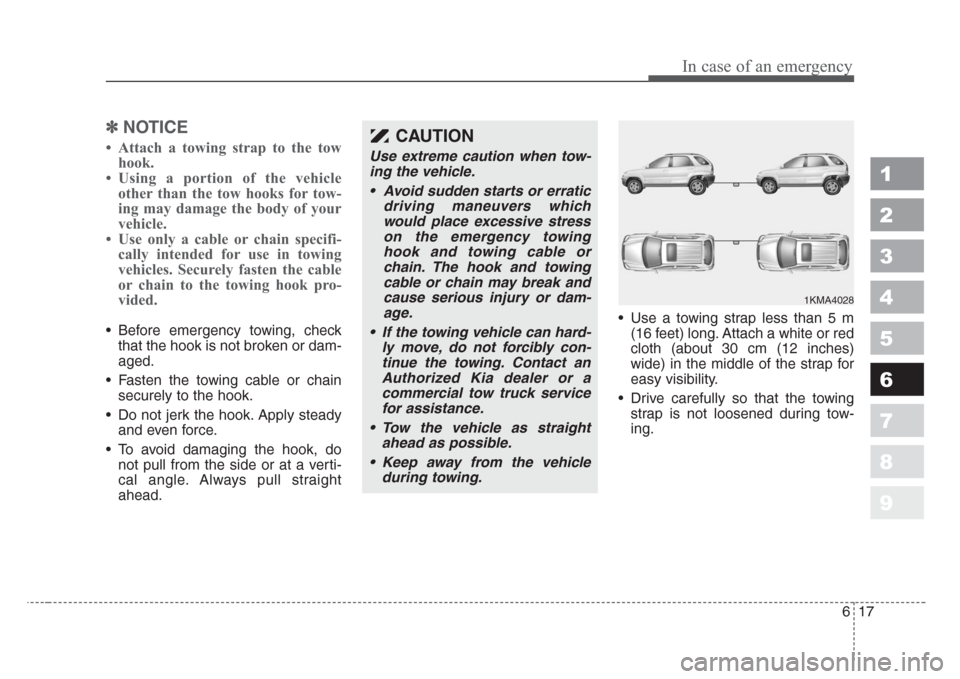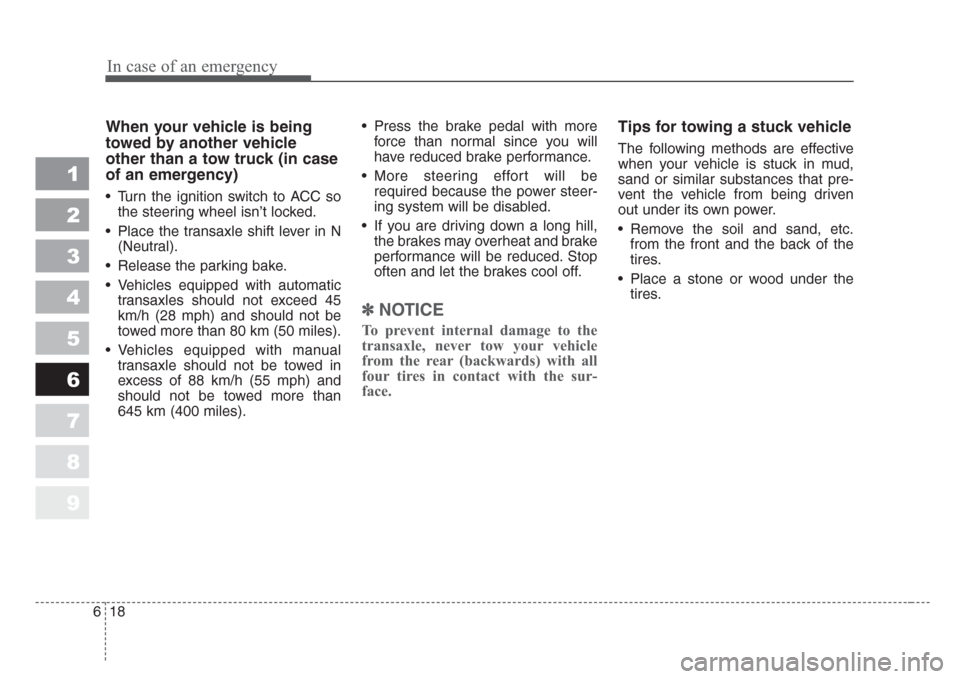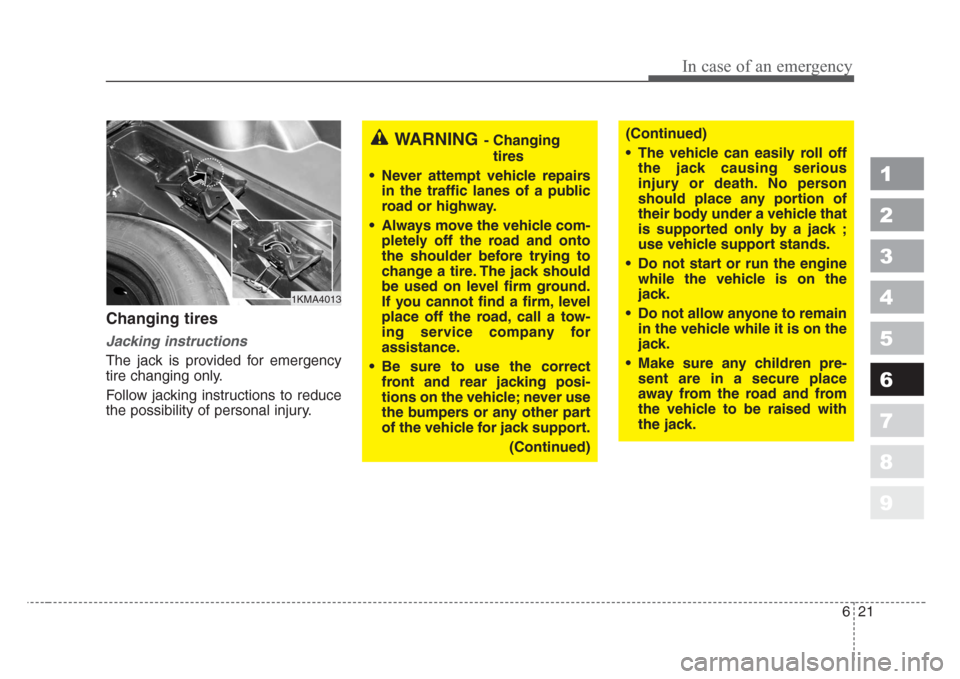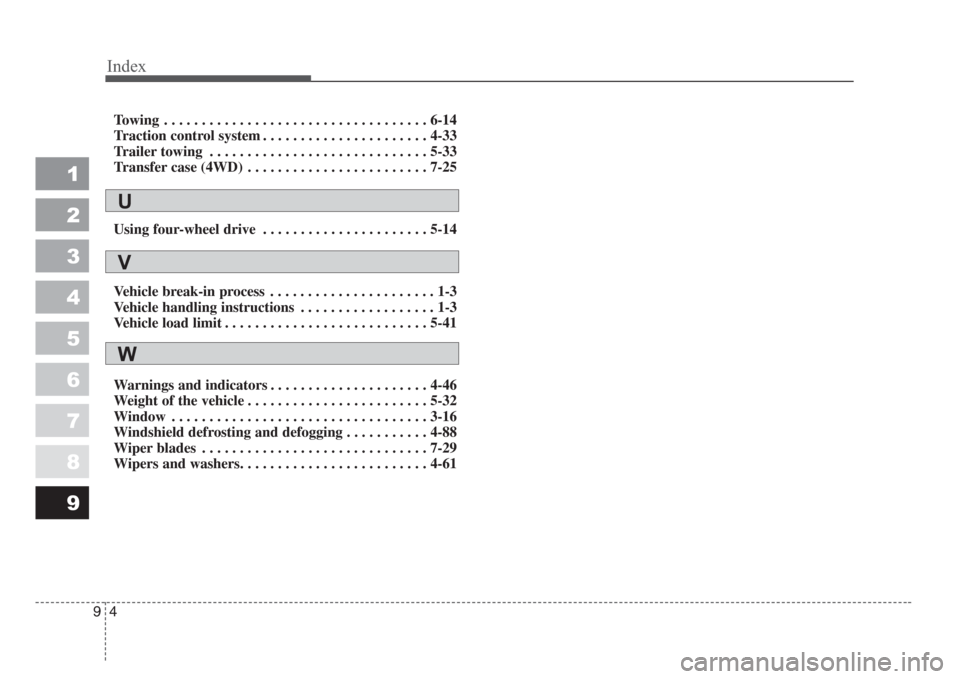Page 279 of 350

617
In case of an emergency
1
2
3
4
5
6
7
8
9
✽
NOTICE
• Attach a towing strap to the tow
hook.
• Using a portion of the vehicle
other than the tow hooks for tow-
ing may damage the body of your
vehicle.
• Use only a cable or chain specifi-
cally intended for use in towing
vehicles. Securely fasten the cable
or chain to the towing hook pro-
vided.
• Before emergency towing, check
that the hook is not broken or dam-
aged.
• Fasten the towing cable or chain
securely to the hook.
• Do not jerk the hook. Apply steady
and even force.
• To avoid damaging the hook, do
not pull from the side or at a verti-
cal angle. Always pull straight
ahead.• Use a towing strap less than 5 m
(16 feet) long. Attach a white or red
cloth (about 30 cm (12 inches)
wide) in the middle of the strap for
easy visibility.
• Drive carefully so that the towing
strap is not loosened during tow-
ing.
CAUTION
Use extreme caution when tow-
ing the vehicle.
• Avoid sudden starts or erratic
driving maneuvers which
would place excessive stress
on the emergency towing
hook and towing cable or
chain.The hook and towing
cable or chain may break and
cause serious injury or dam-
age.
• If the towing vehicle can hard-
ly move, do not forcibly con-
tinue the towing.Contact an
Authorized Kia dealer or a
commercial tow truck service
for assistance.
• Tow the vehicle a
s straight
ahead as possible.
• Keep away from the vehicle
during towing.
1KMA4028
Page 280 of 350

In case of an emergency
18 6
1
2
3
4
5
6
7
8
9
When your vehicle is being
towed by another vehicle
other than a tow truck (in case
of an emergency)
• Turn the ignition switch to ACC so
the steering wheel isn’t locked.
• Place the transaxle shift lever in N
(Neutral).
• Release the parking bake.
• Vehicles equipped with automatic
transaxles should not exceed 45
km/h (28 mph) and should not be
towed more than 80 km (50 miles).
• Vehicles equipped with manual
transaxle should not be towed in
excess of 88 km/h (55 mph) and
should not be towed more than
645 km (400 miles).• Press the brake pedal with more
force than normal since you will
have reduced brake performance.
• More steering effort will be
required because the power steer-
ing system will be disabled.
• If you are driving down a long hill,
the brakes may overheat and brake
performance will be reduced. Stop
often and let the brakes cool off.
✽
NOTICE
To prevent internal damage to the
transaxle, never tow your vehicle
from the rear (backwards) with all
four tires in contact with the sur-
face.
Tips for towing a stuck vehicle
The following methods are effective
when your vehicle is stuck in mud,
sand or similar substances that pre-
vent the vehicle from being driven
out under its own power.
• Remove the soil and sand, etc.
from the front and the back of the
tires.
• Place a stone or wood under the
tires.
Page 283 of 350

621
In case of an emergency
1
2
3
4
5
6
7
8
9
Changing tires
Jacking instructions
The jack is provided for emergency
tire changing only.
Follow jacking instructions to reduce
the possibility of personal injury.
WARNING- Changing
tires
• Never attempt vehicle repairs
in the traffic lanes of a public
road or highway.
•Always move the vehicle com-
pletely off the road and onto
the shoulder before trying to
change a tire.The jack should
be used on level firm ground.
If you cannot find a firm, level
place off the road, call a tow-
ing service company for
assistance.
• Be sure to use the correct
front and rear jacking posi-
tions on the vehicle; never use
the bumpers or any other part
of the vehicle for jack support.
(Continued)(Continued)
• The vehicle can easily roll off
the jack causing serious
injury or death.No person
should place any portion of
their body under a vehicle that
is supported only by a jack ;
use vehicle support stands.
• Do not start or run the engine
while the vehicle is on the
jack.
• Do not allow anyone to remain
in the vehicle while it is on the
jack.
• Make sure any children pre-
sent are in a secure place
away from the road and from
the vehicle to be raised with
the
jack.
1KMA4013
Page 302 of 350

715
Maintenance
1
2
3
4
5
6
7
8
9
ENGINE COOLING SYSTEM
The high-pressure cooling system
has a reservoir filled with year-round
antifreeze coolant. The reservoir is
filled at the factory.
Check the antifreeze protection and
coolant level at least once a year, at
the beginning of the winter season,
and before traveling to a colder cli-
mate.Checking the coolant level
WARNING- Removing
radiator cap
• Never attempt to remove the
radiator cap while the engine
is operating or hot.Doing so
might lead to cooling system
and engine damage and could
result in serious personal
injury from escaping hot
coolant or steam.
• Turn the engine off and wait
until it cools down.Use
extreme care when removing
the radiator cap.Wrap a thick
towel around it, and turn it
counterclockwise slowly to
the firs
t stop.Step back while
the pressure is released from
the cooling system.When you
are sure all the pressure has
been released, press down on
the cap, using a thick towel,
and continue turning counter-
clockwise to remove it.
(Continued)
(Continued)
• Even if the engine is not oper-
ating, do not remove the radi-
ator cap or the drain plug
while the engine and radiator
are hot.Hot coolant and steam
may still blow out under pres-
sure, causing serious injury.
Page 350 of 350

Index
4 9
1
2
3
4
5
6
7
8
9
Towing. . . . . . . . . . . . . . . . . . . . . . . . . . . . . . . . . . . 6-14
Traction control system . . . . . . . . . . . . . . . . . . . . . . 4-33
Trailer towing. . . . . . . . . . . . . . . . . . . . . . . . . . . . . 5-33
Transfer case (4WD) . . . . . . . . . . . . . . . . . . . . . . . . 7-25
Using four-wheel drive . . . . . . . . . . . . . . . . . . . . . . 5-14
Vehicle break-in process . . . . . . . . . . . . . . . . . . . . . . 1-3
Vehicle handling instructions . . . . . . . . . . . . . . . . . . 1-3
Vehicle load limit . . . . . . . . . . . . . . . . . . . . . . . . . . . 5-41
Warnings and indicators . . . . . . . . . . . . . . . . . . . . . 4-46
We ight of the vehicle . . . . . . . . . . . . . . . . . . . . . . . . 5-32
Window . . . . . . . . . . . . . . . . . . . . . . . . . . . . . . . . . . 3-16
Windshield defrosting and defogging. . . . . . . . . . . 4-88
Wiper blades . . . . . . . . . . . . . . . . . . . . . . . . . . . . . . 7-29
Wipers and washers. . . . . . . . . . . . . . . . . . . . . . . . . 4-61
U
V
W